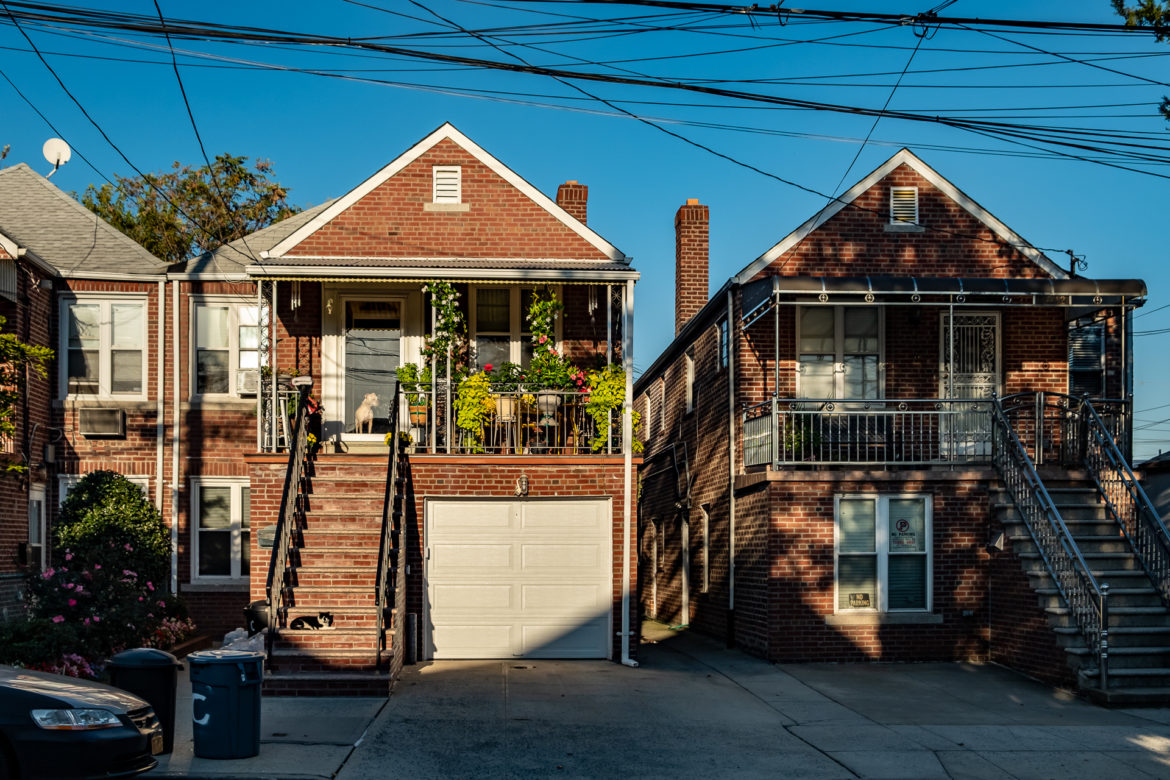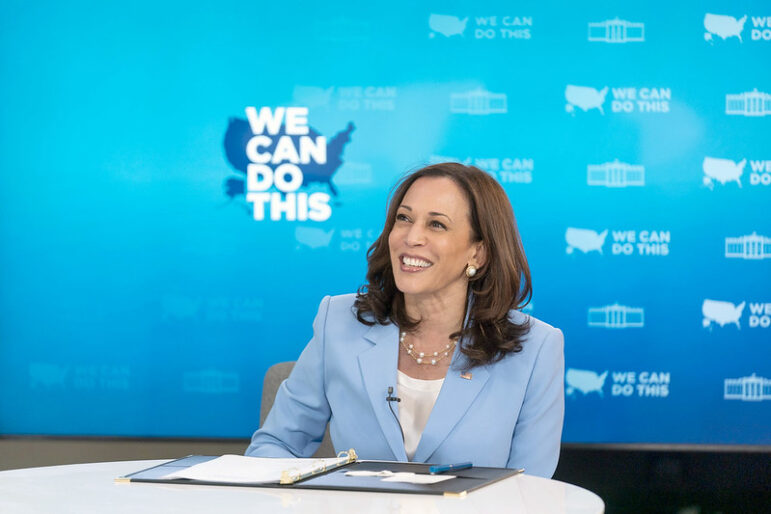Beyond their big-ticket campaign promises, the next president could have substantial impact on housing in New York, from shaping tax incentives that make it easier to build new homes to federal resources for NYCHA and code enforcement programs.

Adi Talwar
Homes on Tomlinson Avenue in Morris Park, The Bronx.
Throughout this presidential election, housing has been a front-and-center issue. Back in June, before President Joe Biden dropped out of the race to endorse Vice President Kamala Harris as the Democratic candidate, he squared off against former President Donald Trump in a debate where the first question probed how the nominees would address rising home prices.
That’s a break from previous years, when housing was often treated like a “third cousin type policy” left to the devices of local governments, says Tara Raghuveer, director of the Tenant Union Federation, a coalition of tenant groups organizing to improve conditions for renters.
That shift, she and other experts say, was largely driven by the increasing severity of the nation’s housing crisis: marked by a shortage of homes, rising rents and unaffordable real estate. “The crisis has gotten deeper and more pronounced than ever before,” Raghuveer said.
“Now I think many, many more people agree that housing is the critical economic issue of our time,” she added. “It’s starting to finally get its due as a core economic issue, and one that requires federal intervention.”
What’s the federal government got to do with it?
The next White House leader could have substantial impact on housing in New York, from shaping tax incentives that make it easier to build new homes to federal resources for NYCHA and code enforcement programs.
“We talk about the whims of the market, but in reality, both federal government, state government and local government, are very actively involved in shaping what the housing market looks like,” said Shamus Roller, executive director at the National Housing Law Project. “The terms upon which lending occurs is so dramatically controlled by federal government policy.”
The president helps shape the budget of agencies like the U.S. Department of Housing and Urban Development (HUD), which operates a number of programs that New York relies on. These include rental assistance vouchers and Community Development Block Grants, which fund “a really high percentage of New York City’s code enforcement programs and emergency repairs,” said Rachel Fee, executive director at the New York Housing Conference.
HUD also funds public housing. At NYCHA, the housing authority is transitioning tens of thousands of apartments from the federal Section 9 program to the more adequately-funded Section 8, which officials say will unlock billions in desperately needed repair funds. “The availability of [federal] funding in order to accomplish that is critical,” said Howard Slatkin, executive director at the Citizens Housing and Planning Council.
Local housing leaders also have their eye on 2025 tax reforms, which the next president and Congress will have to take on after tax cuts impacting affordable housing production expire this year. Particularly critical, Fee says, is expanding the Low-Income Housing Tax Credit, or LIHTC, which makes it easier for developers to build rentals for low-income households, and is one of the biggest drivers of affordable housing production nationwide.
The Housing Conference is pushing for a bill recently introduced by Bronx Congressman Ritchie Torres, dubbed the ASAP Housing Act, which would amend the tax code to lift a volume cap on certain bonds that finance affordable rental housing.
“Because tax reform has to happen this year, I really think a lot is on the line,” Fee said. “We can either be setting up the tax code to make it more favorable to build more affordable housing—or not.”
Harris: down payment help, boosting supply
On that front, LIHTC “has had some bipartisan support,” Fee notes. “But we’ve only seen the Democrats really try to push for expansion.”
On her campaign website, Harris endorses both “a historic expansion of the LIHTC” as well as creating new housing tax credits and incentives. That includes the so-called Neighborhood Homes Tax Credit, which she says would be used to finance the “new construction or rehabilitation of over 400,000 owner-occupied homes” across the country. Another would be a “first-ever tax cut” for developers that build affordable homes for first-time buyers.
Perhaps her most buzzed-about housing campaign idea has also come in the form of encouraging homeownership, by providing up to $25,000 in down-payment assistance for “working families who have paid their rent on time for two years” and are looking to buy for the first time.
That “obviously has a huge appeal to voters,” Fee said. “Everybody wants to be part of that American dream and get their foot on the property ladder.”

Official White House Photo by Lawrence Jackson
Vice President Harris at an event in 2021.
Harris’ housing plan additionally calls for increasing the overall housing supply nationwide by launching a $40 billion “Local Innovation Fund,” which would be doled out to state and local governments that “show that they will deliver results in building rental properties and homes that are affordable.”
“It’s really important to have a federal government that’s supportive of increasing the supply and availability of housing,” said Slatkin, of the Citizens Housing and Planning Council. This is work New York City is already doing—Mayor Eric Adams’ City of Yes for Housing plan, for example, is looking to build more citywide by easing zoning restrictions.
“We shouldn’t be limiting our focus to New York City,” Slatkin said. “New York City is part of a region which has a huge housing crunch, and things that make it easier and more possible and more achievable and more likely that suburban communities are going to increase the availability of housing, and the variety of types of housing available in their boundaries, is a huge addition as well.”
Earlier in her campaign this summer, Harris also floated the idea of capping rent increases—echoing an earlier plan put forth by Biden, who made a similar proposal in July, calling for lawmakers to pass legislation that would force “corporate landlords” to choose between federal tax breaks or limiting rent hikes at 5 percent.
Harris’ current campaign website, though, doesn’t specify a rent cap pledge. “In the last couple of months, she has shifted away from those messages and towards messages that are much more focused on the private market, I think, to her detriment,” said Raghuveer of the Tenant Union Federation.
“I don’t encounter a lot of people who are convinced that their pain will be alleviated by down payment assistance and tax credits for developers,” she added. “That’s not necessarily a compelling agenda for poor and working class tenants in this country. Rent caps are very compelling agenda for those people.”
Harris’ housing platform does promise to champion legislation that would “crack down on companies that contribute to surging rent prices” by targeting price-setting practices through antitrust laws, and by removing tax benefits for corporate real estate companies that buy up single-family rentals.
Those proposals recognize “a real growth of corporate and institutional landlords” over the last several years, according to Roller at the National Housing Law Project. “We also really need the federal government to help level the playing field across the board for tenants, so that they have a basic level of rights moving forward,” he said.
Trump: light on details, heavy on deportations
By contrast, Republican candidate and former President Trump’s housing platform is far less substantive. A GOP document linked to on his campaign website includes just a paragraph specific to “housing affordability.”
“To help new home buyers, Republicans will reduce mortgage rates by slashing Inflation, open limited portions of Federal Lands to allow for new home construction, promote homeownership through Tax Incentives and support for first-time buyers, and cut unnecessary Regulations that raise housing costs,” it reads.
According to Slatkin, those “unspecified tax incentives” for home buyers “could be fine”—but it’s hard to say without more details, and his main concern would be the federal government “offering tax incentives to people that don’t need tax incentives.”
Likewise, the idea of opening up more federal land for housing construction, “there’s nothing inherently wrong about looking at that,” Slatkin said. But its impact would likely be limited.
“There’s enormous amounts of federal land out west, but that’s not where we’re going to solve our housing crisis either, because that’s not where the jobs and employment opportunities are,” he said.

Official White House Photo/Shealah Craighead
President Donald J. Trump delivers a speech at the border wall near the Texas-Mexico border on Jan. 12, 2021.
Where Trump has been most vocal around housing: his proposal to “carry out the largest deportation operation in American history.”
“Republicans will secure the Border, deport Illegal Aliens, and reverse the Democrats’ Open Borders Policies that have driven up the cost of Housing,” the GOP campaign platform on Trump’s website reads.
Experts have questioned both the costs and legal feasibility of that idea. “His policy as of right now is, deport immigrants. That is not a housing policy, and it’s racist,” Raghuveer said.
Removing large numbers of undocumented immigrants from the country would actually undermine efforts to address the nation’s housing shortage, as it would “decimate our construction workforce,” Roller said.
“One of the major challenges that we face in building more housing is the cost, and the cost of construction labor, and the lack of skilled trades workers,” he added. “We lost so many people who worked in the construction trade in the foreclosure crisis, and we’ve never really got back up again.”
In lieu of a more detailed housing plan, advocates say they could glean some aspects of what a second Trump term could entail by looking back at his previous four years in office.
“I was doing affordable housing advocacy during the last Trump administration, and we saw really serious threats to the HUD budget,” said Fee of the New York Housing Conference.
While lawmakers in Congress were largely able to hold the line against those threats, they included proposed cuts to public housing, to Community Development Block Grants that fund emergency repairs and to the HOME program, which supports the building and rehab of affordable housing.
“The Trump administration proposed significant cuts to federal housing programs, while the Biden administration has proposed increases to those programs,” said Roller. “And Harris obviously isn’t Biden, but I think we can have some sense of what the likely outcome would be under each of those candidates.”
To reach the editor, contact Jeanmarie@citylimits.org
Want to republish this story? Find City Limits’ reprint policy here.














